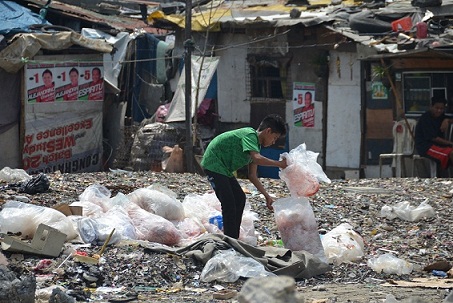By MELISSA LUZ LOPEZ
VALENZUELA lives up to its label as ‘plastic city.’
Although 11 of 17 cities in Metro Manila have already imposed a ban on the use of plastics, Valenzuela City still stands firm on refusing to follow their lead.
There will still be no plastic ban in Valenzuela, which has plastic manufacturing as “its trademark.”
The local government is under the leadership of Mayor Sherwin Gatchalian— the son of plastics king William Gatchalian. The Gatchalian family owns the 60-hectare “Plastic City” estate in Valenzuela.
While a plastic ban seems to be out of the question, there have been initial efforts to regulate the use of plastic sando bags in the city.
In 2011, Sangguniang Kabataan Valenzuela City Federation president Cristina Marie Feliciano and Councilor Marlon Alejandrino filed an ordinance that seeks to prohibit the use of plastic carry-out bags in all establishments three days a week– on Mondays, Wednesdays and Fridays. The ordinance, which remains pending in the Sangguniang Panlungsod at presstime, only reached first reading.
 “Regulation lang dito sa Valenzuela, hindi dapat i-ban, kasi sisirain ang industriya at maraming mawawalan ng trabaho (Here in Valenzuela, we should regulate and not ban [the use of plastic bags] for it will greatly affect the industry and jobs will be lost),” Ceasar Peralta of the Clean and Green Office said.
“Regulation lang dito sa Valenzuela, hindi dapat i-ban, kasi sisirain ang industriya at maraming mawawalan ng trabaho (Here in Valenzuela, we should regulate and not ban [the use of plastic bags] for it will greatly affect the industry and jobs will be lost),” Ceasar Peralta of the Clean and Green Office said.
There were 324 plastic and rubber manufacturing companies in the city in 2011, according to the Valenzuela City Planning and Development Office (CPDO).
Peralta said that plastic waste contributes to heavy flooding because it blocks the water canals along streets. Valenzuela City is a flood-prone area, especially during the rainy season.
In 2012, more than 46,000 tons of waste materials were collected by the city’s Waste Management Office (WMO). Of this, 9,200 tons (or 20 percent) were made of plastic. Despite the WMO’s efforts to conduct truck rounds twice a day, some residents would still dump their trash in nearby drainages, Peralta observed.
According to Stevenson Tavera of the Philippine Plastics Industry Association (PPIA), plastic waste is not the main cause of heavy floods in Valenzuela, particularly during the tropical storm Ondoy in 2009 as had been claimed in some reports.
Tavera claimed the floods were caused by excessive rains and not by plastic waste, citing reports from the Philippine Atmospheric, Geophysical and Astronomical Services Administration (PAGASA) and from the Department of Public Works and Highways (DPWH).
Siltation, or the settling of heavier waste materials at the bottom of creeks and canals, could have played a bigger role during the Ondoy tragedy, he explained.
To address the flooding problem, Peralta said they are conducting information campaigns to educate residents on proper waste segregation and disposal.
Michael Reyes from the Environmental Police Unit added that the campaigns encourage residents to gather their plastic waste and sell it to junkshops, as part of the city’s plastic and Styrofoam recovery project.
A total of 250 junkshops and 92 plastic recycling plants were registered with the WMO in 2012.
Along with the PPIA, the WMO also partnered with the Polystyrene Packaging Council of the Philippines (PPCP) to boost the city’s efforts in recycling and recovery.
Ramil Ascueta of the PPCP said his group was amenable to the regulation of plastic use, but not to a total ban.
After a number of cities in Metro Manila implemented a plastic ban in 2011, plastic manufacturing companies experienced a huge drop in sales and struggled to keep their employees on the job. Latest data from the PPIA showed that some 175,000 factory workers were affected by the plastic ban. Companies have also suffered as much as an 80-percent drop in their total sales.
According to Tavera, one of the biggest factories in the PPIA produces around 10 metric tons of plastic bags daily. After the local ordinances were enacted, the factory could only sell one to two metric tons per day.
“It (plastic ban) is almost killing the industry, though they say it is [only a] regulation,” Tavera said.
The cities of Pasig, Muntinlupa, Las Piñas, Quezon, Mandaluyong, Pasay, Taguig, Makati, Malabon, Marikina and the municipality of Pateros have implemented plastic ban ordinances. Local versions of the plastic ban have also been adapted in several provinces like Laguna and Bulacan.
Along with Valenzuela, the cities of Navotas, Caloocan, San Juan, Parañaque and Manila remain plastic ban-free as of this writing.
CPDO head Josefina Acurantes believes it will take a long time before the use of plastic bags in Valenzuela could be stopped.
“Syempre marami kaming plastic companies dito, nagge-generate yan ng employment sa mga taga-Valenzuela, kaya hindi ganoon kadali [mag-ban] (We have a lot of plastic companies here which generate employment for Valenzuela residents, that’s why it’s very difficult to enforce a plastic ban),” Acurantes explained.
(Melissa Luz Lopez is a University of the Philippines journalism student who is writing for VERA Files as part of her internship.)
